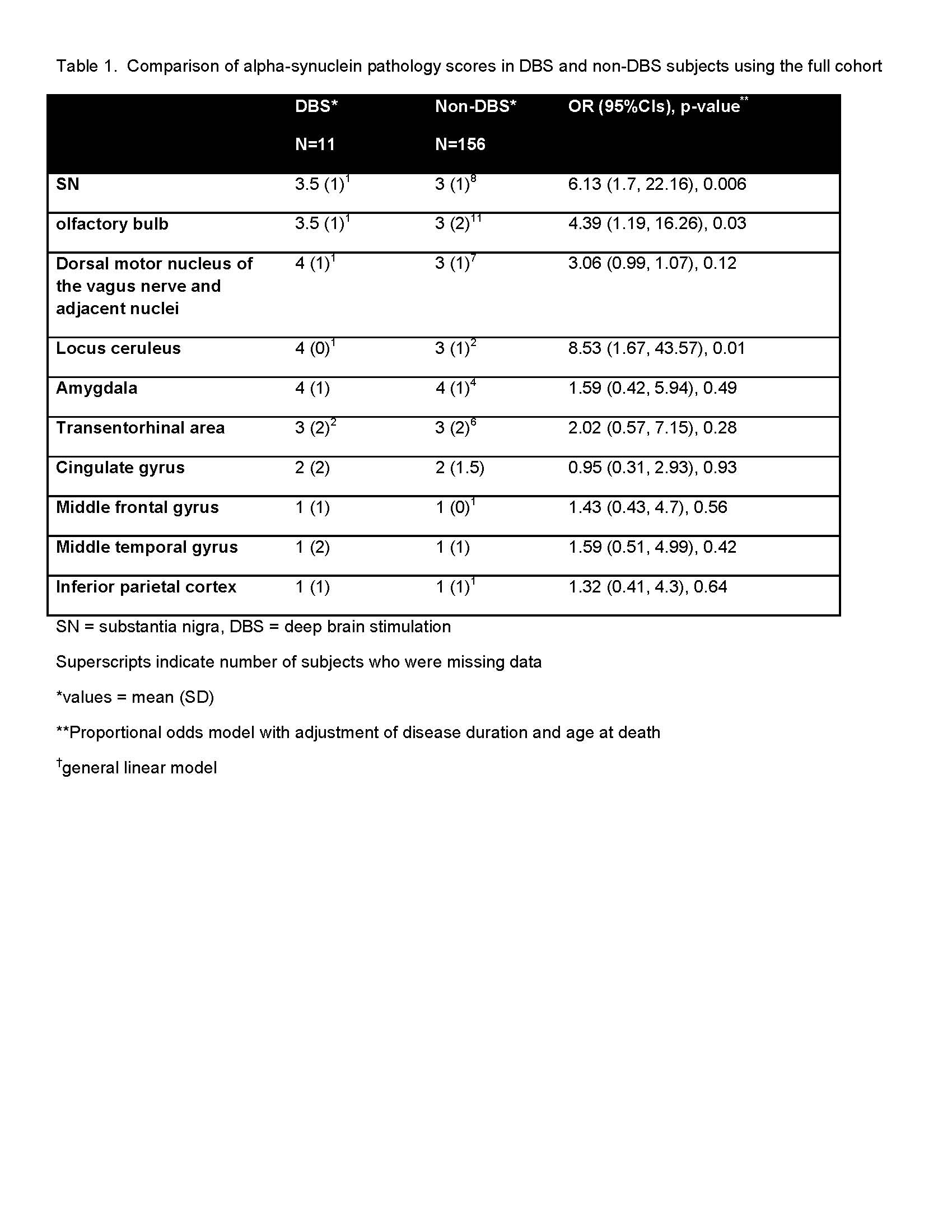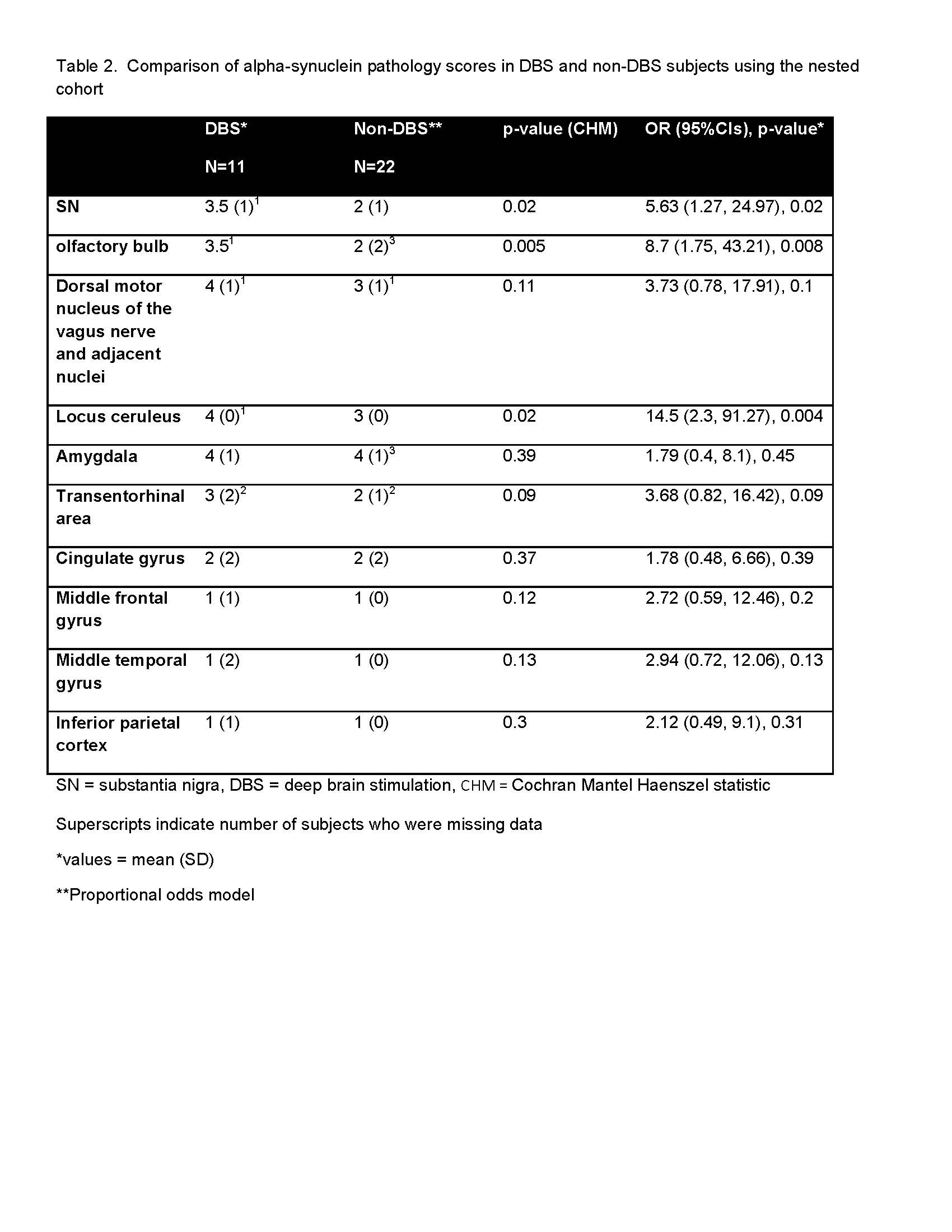Session Information
Date: Monday, June 5, 2017
Session Title: Surgical Therapy: Parkinson’s Disease
Session Time: 1:45pm-3:15pm
Location: Exhibit Hall C
Objective: The aim of this postmortem study was to compare, in Parkinson’s disease subjects with and without bilateral subthalamic nucleus deep brain stimulation (STN-DBS), the loss of pigmented neurons within the substantia nigra and pathological alpha-synuclein density within the SN and other brain regions.
Background: Deep brain stimulation (DBS) is a well-accepted treatment for Parkinson’s disease (PD). As no neuroprotective therapy for PD exists to date, there is considerable interest in determining the neuroprotective potential of DBS.
Methods: PD subjects were identified from the Arizona Study of Aging and Neurodegenerative Disorders database (STN-DBS = 11, non-DBS = 156). Pigmented neuron loss scores within the substantia nigra as well as alpha-synuclein density scores within the substantia nigra and 9 other brain regions were compared, the latter individually and in summary as the Lewy body brain load score.
Results: DBS subjects (n = 11) and non-DBS subjects ( n = 156) were not significantly different regarding sex, MMSE scores, MMSE-Interval, UPDRS-III ON, UPDRS-III OFF, or UPDRS-Interval (p > 0.05). Based on analysis of the full cohort using the POM, DBS implantation was associated with a 6.1-fold increased odds of higher alpha-synuclein density within the SN when adjusted for age of expiration and disease duration. DBS implantation was also associated with a 4.4-fold and 8.5-fold increased odds of higher alpha-synuclein density within the olfactory bulb and locus ceruleus, respectively. The DBS group had higher total LBBL scores, approaching the significance level (28.8 ± 6.1 vs. 24.2 ± 7.7, respectively, p = 0.06) [table 1]. The SN pigmented neuron loss score did not differ between the two groups (p = 0.64). Using CMH statistics with the nested cohort with matched triplicates (DBS n = 11, non-DBS n = 22), DBS subjects had higher alpha-synuclein density scores within the substantia nigra (5.6 fold increased odd), olfactory bulb (8.7-fold), and locus ceruleus (14.5-fold) [table 2]. The total LBBL scores were significantly higher in the DBS subjects compared with non-DBS subjects (28.8 ± 6.1 vs. 22.1 ±7.0, respectively, p = 0.02). The SN pigmented neuron loss score did not differ between the two groups (p = 0.22).
Conclusions: STN-DBS subjects tend to have higher alpha-synuclein density scores, but do not have a differential loss of substantia nigra pigmented neurons.
To cite this abstract in AMA style:
G. Pal, B. Ouyang, G. Serrano, H. Shill, C. Goetz, G. Stebbins, L. Metman, E. Driver-Dunckley, S. Mehta, J. Caviness, M. Sabbagh, C. Adler, T. Beach. Comparison of neuropathology in Parkinson’s disease subjects with and without deep brain stimulation [abstract]. Mov Disord. 2017; 32 (suppl 2). https://www.mdsabstracts.org/abstract/comparison-of-neuropathology-in-parkinsons-disease-subjects-with-and-without-deep-brain-stimulation/. Accessed December 28, 2025.« Back to 2017 International Congress
MDS Abstracts - https://www.mdsabstracts.org/abstract/comparison-of-neuropathology-in-parkinsons-disease-subjects-with-and-without-deep-brain-stimulation/


